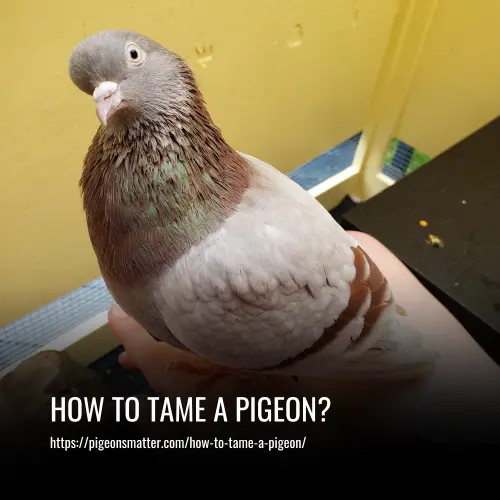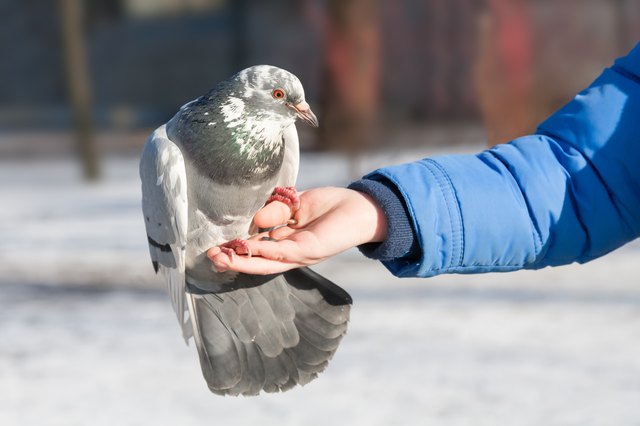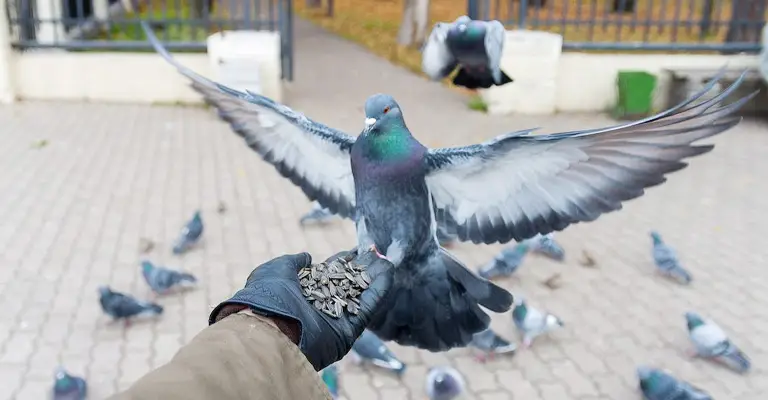How To Tame A Pigeon?
This post contains affiliate links. As an Amazon Associate, we earn from qualifying purchases.
Taming a pigeon may seem like a daunting task, but with the right approach and understanding, anyone can successfully bond with these intelligent and social birds. Whether you are looking to keep a pigeon as a pet or want to train them for a specific purpose, learning how to tame and build trust with these creatures is essential.
To Tame A Pigeon, Follow These Steps:
- 1. Understanding Pigeons Behavior
- 2. Creating the Right Environment
- 3. Building Trust
- 4. Allowing Freedom
- 5. Essential Care for Pet Pigeons
- 6. Training and Bonding

How To Tame A Pigeon
When it comes to taming a pigeon, It’s important to approach the pigeon cautiously, respecting their space and establishing trust and comfort. Here are some tips on how to tame a pigeon:
1. Understanding Pigeons Behavior
Pigeons are fascinating birds that possess unique qualities and abilities. By observing their behavior and studying their characteristics, we can gain a deeper understanding of these remarkable creatures.
1. Adaptability and Travel
Pigeons are known for their exceptional ability to adapt to various environments and travel long distances. This adaptability has made them invaluable to humans throughout history, as they have been domesticated and used as messengers in wars. Their capacity to bond with humans is a testament to their intelligence and social nature.
2. Intelligence and Communication
Pigeons display remarkable intelligence, as they can recognize themselves in mirrors and comprehend complex patterns. They also communicate with each other using cooing sounds, showcasing their ability to convey messages within their groups.
3. Ecological Importance
While some may view pigeons as pests, they actually play an essential role in controlling insect populations and dispersing seeds. Their contribution to the ecosystem should not be overlooked, as they assist in maintaining the balance of nature.
4. Contribution to Science
Pigeons have been extensively studied in animal cognition, providing valuable insights into learning, memory, and problem-solving. Their cognitive abilities have shed light on various aspects of intelligence and have contributed to our understanding of these processes in other animals as well.
5. Homing Instinct and Navigation
One of the most fascinating aspects of pigeons is their homing instinct. They possess the ability to return to their roosts even when released from unfamiliar locations. Scientists believe that pigeons utilize magnetic cues, landmarks, and celestial navigation to navigate their way home. This unique skill has been utilized in navigation and mapping studies.
2. Creating the Right Environment
Creating the right environment is crucial for taming a wild pigeon. Here are some important factors to consider to ensure the bird feels safe and comfortable:
1. Provide a Spacious and Secure Enclosure
The enclosure should be large enough for the pigeon to move around freely without feeling confined. It should be made of strong materials to prevent the pigeon from escaping and to protect it from predators.
2. Maintain a Peaceful and Quiet Atmosphere
Loud noises and sudden movements can scare pigeons. It is important to minimize disturbances and keep the area as calm and quiet as possible to help the pigeon feel at ease.
3. Ensure Good Lighting and Ventilation
Sufficient natural light and fresh air are essential for the pigeon’s overall health. Proper ventilation helps maintain a clean and healthy environment, while adequate lighting helps regulate the bird’s sleep-wake cycle.
4. Provide Suitable Perches and Nesting Areas
Pigeons feel safe when they have elevated perches to rest on. Offer a variety of perching options such as branches or platforms, allowing the pigeon to choose its preferred spot. Additionally, provide nesting materials and a secluded area for breeding to create a more suitable environment for the bird.
5. Consider Breed-Specific Needs
Different pigeon breeds have specific preferences and requirements. Some breeds thrive in cooler climates, while others prefer warmer temperatures. It is important to research the specific needs of the pigeon’s breed to create the most suitable environment.
3. Building Trust
Gaining a pigeon’s trust is crucial for establishing a strong bond. Regular feeding plays a vital role in building trust with these social animals. By providing food at consistent times, pigeons feel safe and secure, associating regular feeding with care and reliability.
1. Establishing a Routine
Feeding pigeons at specific times creates predictability and comfort for them. They learn to anticipate your presence and see you as a source of sustenance.
2. Positive Reinforcement
Offering food during these regular feeding sessions encourages pigeons to approach without fear. They associate your presence with a positive experience and begin to trust you.
3. Fulfilling Basic Needs
Regular meals meet the pigeons’ essential survival needs, and they come to rely on you for their sustenance. This dependency strengthens the bond between you and the birds.
4. Showing Care and Reliability
Providing nourishment demonstrates your commitment to the pigeons’ well-being. They view you as a reliable caregiver, which further enhances their trust in you.
While regular feeding is an important factor in building trust, it is not the only one. Consider the overall environment in which the pigeons are kept, engage in trust-building activities, and allow them some freedom. These additional factors contribute to establishing a strong and lasting connection with the birds.
4. Allowing Freedom
Building trust and creating a harmonious environment for your pet pigeon is crucial for their well-being. Regular feeding and leaving their cage open during the day are key practices in establishing trust and promoting mental and physical stimulation.
1. Regular Feeding
By maintaining a routine feeding schedule, you establish a sense of reliance and trust with your pet pigeon. They come to expect and rely on you for their food, which strengthens the bond between caregiver and bird. Additionally, regular feeding allows caregivers to monitor any changes in appetite, ensuring the bird’s nutritional needs are met.
2. Open Cage
Allowing your pigeon to fly outside of their cage provides them with mental and physical stimulation. It gives them the freedom to explore their surroundings, interact with other animals, and engage in natural behaviors like building nests. This freedom helps prevent obesity and promotes healthy flight and exercise.
3. Improved Nutrition and Health
Regular feeding and open cages contribute to improved nutrition and overall health. Caregivers can observe any changes in appetite or behavior that may indicate illness or nutritional deficiencies. By providing a varied and balanced diet, caregivers can ensure their pet pigeon remains healthy and happy.
4. Joy and Observation
Engaging in trust-building activities brings joy to both the caregiver and the bird. Caregivers have the opportunity to witness their pigeon’s actions, such as nest-building and interactions with other animals. This creates a harmonious and enriching environment for the pigeon to thrive, fostering a stronger bond between caregiver and bird.

5. Essential Care for Pet Pigeons
To ensure the well-being of your pet pigeon, it’s important to recognize the essential care they require. Ignoring these responsibilities could lead to health issues or an unhappy bird.
1. Choosing the Right Cage
When selecting a cage for your pet pigeon, consider factors such as ventilation and durable materials. It should be spacious enough for them to move around comfortably and include multiple perches. Create a secluded nesting area to allow for natural behaviors.
2. Proper Nutrition and Feeding
Provide a varied diet for your pet pigeon, including pellets, fresh fruits, and vegetables, and grit or crushed oyster shells for digestion. Avoid overfeeding and monitor their weight. Make sure fresh water is always available.
3. Creating a Safe and Comfortable Environment
Assess your bird’s condition before bringing them home and provide suitable housing with secure locks. Set up a calm indoor area away from disturbances and offer outdoor access for natural activities. Provide perches and nests of varying heights and maintain cleanliness by regularly cleaning the cage and replacing bedding.
4. Companionship and Ethical Considerations
Pigeons require companionship either from another pigeon or human interaction. It’s important to follow legal guidelines and ethical considerations when keeping pet pigeons. Consider alternatives such as buying from breeders or adopting domesticated pigeons from rescues.

6. Training and Bonding
Training and bonding with your pigeon can create a strong and trusting relationship. Here are some tips to help you with the process:
1. Use Positive Reinforcement
Reward your pigeon with treats or praise when they exhibit desired behavior. This will create a positive association and motivate them to continue performing well.
2. Create a Safe Environment
Provide a cage or aviary where your pigeon feels secure and protected. This will help them feel more comfortable and build trust in their surroundings.
3. Feed the Pigeon Regularly
Regular feeding times will help your pigeon associate you with a source of food, gaining their trust and establishing a bond.
4. Approach Calmly and Quietly
Sudden movements or loud noises can startle pigeons, so it’s important to approach them calmly and quietly. This will help them feel at ease in your presence.
5. Introduce Basic Commands
Teach your pigeon simple commands, such as “come” or “stay,” to establish communication and understanding. This will enable you to guide their behavior and further strengthen your bond.
6. Be Patient and Consistent
Training takes time, so it’s important to be patient and consistent with your methods. Pigeons learn through repetition, so regular training sessions will help them understand and retain the information.
7. Respect the Pigeon’s Natural Instincts
Pigeons have innate instincts that should be respected. Understanding and working with these instincts will help build a strong bond and serve as a foundation for more advanced training.
By following these tips, you can create a positive training experience for your pigeon and build a strong bond based on trust and understanding.
How Long Does It Take To Tame A Pigeon
Taming a pigeon typically takes around two weeks. During this time, you’ll need to build trust with the bird and gradually get it accustomed to being around humans. It’s important to be patient and consistent in your efforts.
What Are The Benefits Of Taming A Pigeon
Taming a pigeon can have several benefits. Firstly, you can have a loyal friend that will bond with you and provide companionship. Tamed pigeons can also be trained to do tricks and perform various behaviors, which can be entertaining and enjoyable.
Additionally, pigeons are generally low maintenance pets, requiring minimal care compared to other animals. Overall, taming a pigeon can bring joy, companionship, and entertainment to your life.
Challenges To Tame A Pigeon
Taming a pigeon can be a rewarding experience, but it does come with challenges. Understanding and addressing these challenges is important for a successful taming process.
1. Fear or Anxiety
When taming a pigeon, it’s common for them to be fearful or anxious, especially if they’re not used to human interaction. This can result in avoidance, escape attempts, or even aggressive behaviors like pecking or biting. To address this, create a calm and safe environment for the pigeon. Minimize stressors and give them time to adjust to their surroundings.
2. Resisting Touch or Handling
Some pigeons may resist being touched or handled, particularly in the early stages of taming. Be patient and give them time to become comfortable with physical contact. Gradually introduce touch and handle them gently. Positive reinforcement, such as treats or praise, can help them associate touch with positive experiences.
3. Not Responding to Training Cues
Pigeons may not immediately respond to training cues, such as stepping onto a stick or your hand. This can be due to unfamiliarity or fear. Stay patient and consistent in your training efforts. Break down training into small steps and reward any progress. Eventually, the pigeon will learn to respond to cues through positive reinforcement.
How To Solve The Challenges
Dealing with these challenges can be frustrating, but there are effective ways to address and overcome them:
1. Create a Calm Environment
Reduce environmental stressors in your pigeon’s surroundings. Make sure their space is quiet, safe, and comfortable. Provide hiding spots and enrichments, such as perches and toys, to make them feel secure.
2. Be Patient and Consistent
Take your time and avoid rushing the process. Build trust and a positive relationship by consistently interacting with your pigeon in a calm and gentle manner. Establish a routine for feeding, cleaning, and handling to create a sense of predictability.
3. Use Positive Reinforcement
Reward your pigeon for positive behavior to reinforce good habits. Use treats, gentle praise, or gentle touch as rewards when they exhibit desired behaviors, such as stepping onto your hand or perching on your arm. This will encourage them to repeat these actions.
4. Seek Advice from Experts
If you encounter specific challenges, do not hesitate to seek guidance from avian experts or experienced pigeon owners. They can provide valuable insights and advice based on their knowledge and experiences. They may suggest specific techniques or exercises to help address your pigeon’s specific issues.
Remember that every challenge is an opportunity for learning and growth. By addressing these issues with patience, understanding, and consistent effort, you can successfully overcome them and build a strong bond with your pigeon.
FAQs
Yes, it is possible to tame any pigeon. However, the temperament and past experiences of each individual pigeon may affect the ease of the taming process.
The time it takes to tame a wild pigeon can vary greatly. It can take anywhere from a few weeks to several months, depending on the bird’s level of trust and previous experiences with humans. Patience and consistency are key when taming a wild pigeon.
If a wild pigeon doesn’t want to eat from your hand, keep offering food to them regularly and make sure you’re not threatening or intimidating them. With time, the pigeon might become more comfortable and start eating from your hand.
While it is possible to release a tamed pigeon back into the wild, it should be done with careful consideration. The pigeon should be given a chance to adapt and survive in its natural habitat before being released.
Laws regarding the keeping and taming of wild pigeons may vary depending on your location. It is important to research and understand the local regulations to ensure that you are in compliance with the law.
To tame a pigeon in a big cage, you need to be patient and spend time with the bird every day. Create a safe and comfortable environment in the cage with perches, toys, and food and water dishes. Speak softly and offer food treats to gain the bird’s trust. Avoid sudden movements or loud noises that might scare the pigeon.
It is generally easier to tame a baby pigeon, but with patience and consistent effort, adult pigeons can also be tamed.
If your pigeon is getting tamed, it will show signs of being comfortable around you. These signs include eating from your hand, willingly perching on your hand or arm, and not showing signs of stress or fear when you are near.
If your pigeon seems scared of you, it’s important to give them space and time to adjust. Be calm and gentle in your interactions, and try to be consistent with your approach. Over time, your pigeon should start to feel more comfortable around you.
Yes, you can tame more than one pigeon at a time. Just keep in mind that each pigeon is different and may require individual attention and training. They may also progress at different speeds in their tameness.
Conclusion
In conclusion, taming a pigeon requires patience, consistency, and understanding of their behavior. By using positive reinforcement and establishing trust, you can build a strong bond with your pigeon and train them effectively. Remember to create a safe and comfortable environment for your pigeon, and always approach them with respect and kindness.
With the right approach, you can enjoy a rewarding relationship with your feathered friend and have a well-behaved pet pigeon. So, take the time to understand and connect with your pigeon, and you will be rewarded with a loyal and affectionate companion.